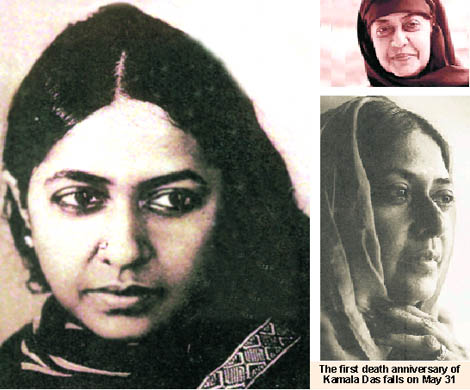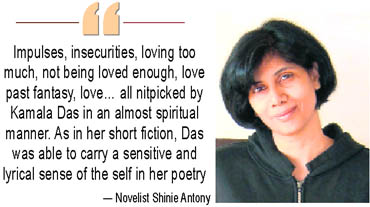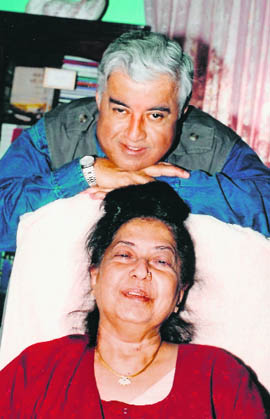|
For better and for verse
A woman of verse and verve. Not only did poetess and writer Kamala Das’
works articulate unconventional views and beliefs, but as a woman, too,
she shattered stereotypes, writes Humra Quraishi
 KAMLA
Das was one of those poets whose verse and words spread out. Maybe, it’s
because of the image she’d built or the unconventional views she
aired, not to forget the personal upheaval she’d been through –
falling in love with a Muslim doctor and converting to Islam. And, as
in the case of most love affairs, the going wasn’t smooth, leaving
her forlorn and in deep sorrow. Perhaps, she released much of that
pain through her verse, through the stories she gently weaved, through
the connectivity she built over the years ...
As K. Satchidanandan, a
Malayalam poet, bilingual critic, translator and former secretary of
the Sahitya Akademi, puts it, "As a poet, Kamala was a pioneer:
She took Indian poetry in English far ahead of her women predecessors,
like Toru Dutt and Sarojini Naidu, giving it a new feminine charm, a
confessional quality and, yes, a political slant. She always
identified with the downtrodden, the maidservants, the so-called lower
caste helpless women exploited by landlords. Her poems on the
anti-Sikh riots in Delhi and on the plight of Tamils in Sri Lanka are
powerful indictments of the ethnic hatred and genocide of our times.
 "While
she was different from her women predecessors, she was also different
from her male contemporaries, like A. K. Ramanujan, Keki Daruwalla,
Nizim Ezekiel and others, as she brought a distinct emotional quality
to Indian English poetry by weaving her poems around women’s bodily
desires and a spiritual love`A0in the tradition of Mirabai, that only
women can articulate and fully expressed in her poems on Krishna as
well as on Allah in her collection Ya Allah! No wonder, she
became a role model for almost all Indian English women poets who rose
to fame later, like Eunice D’Souza, Charmagne D’Souza, Rukmini
Bhaya Nair and Imtiaz Dharker and younger ones like Priya Sarukai
Chhabria and Arundhati Subramaniam, despite the differences in style. "While
she was different from her women predecessors, she was also different
from her male contemporaries, like A. K. Ramanujan, Keki Daruwalla,
Nizim Ezekiel and others, as she brought a distinct emotional quality
to Indian English poetry by weaving her poems around women’s bodily
desires and a spiritual love`A0in the tradition of Mirabai, that only
women can articulate and fully expressed in her poems on Krishna as
well as on Allah in her collection Ya Allah! No wonder, she
became a role model for almost all Indian English women poets who rose
to fame later, like Eunice D’Souza, Charmagne D’Souza, Rukmini
Bhaya Nair and Imtiaz Dharker and younger ones like Priya Sarukai
Chhabria and Arundhati Subramaniam, despite the differences in style.
"As a short story
writer in Malayalam, she went ahead of her predecessors like
Lalitambika Antarjanam and K. Saraswati Amma in terms of sensibility
as well as idiom. She brought the short story close to the lyrical,
infusing narrative situations with a`A0luminous poetic quality and
building her stories around images rather than events. Her stories
were more expressions of the inner drama of the modern man’s (and
woman’s) conflict-ridden and asphyxiated mind, closer to soliloquies
than articulations of the outer drama of historical and social events.
She easily crossed over from one genre to another; many of her poems
have a narrative quality, while many of her stories are almost like
poems.
 "Her
autobiography My Story , which she kept revising all through
her later years and kept the readers guessing as to whether all those
love affairs were real or imagined, is one of the most lyrical and
heart-rending memoirs ever written in India. Kamala will be remembered
for long for having championed a breakthrough in the way we perceive
human reality." "Her
autobiography My Story , which she kept revising all through
her later years and kept the readers guessing as to whether all those
love affairs were real or imagined, is one of the most lyrical and
heart-rending memoirs ever written in India. Kamala will be remembered
for long for having championed a breakthrough in the way we perceive
human reality."
Perhaps what had got her
close, almost face to face with the reader, was the simplicity of her
verse. There were no complex weaves or that stumbling interplay of
high-sounding words. All very direct. All very touching. As novelist
and short story writer Shinie Antony, who also hails from Kerala,
comments, "Impulses, insecurities, loving too much, not being
loved enough, love past fantasy, love`85 all nitpicked by Kamala Das
in an almost spiritual manner. As in her short fiction, Das was able
to carry a sensitive and lyrical sense of the self in her poetry. For
instance, she concludes the poem "The Looking Glass" with
such pathos that it is difficult not to identify with that level of
pain. She says: ‘Oh yes getting/ A man to love is easy but
living/ without him afterwards may have to be/ Faced a living without
life when you move/ Around meeting strangers`85’ Emotional
truisms applicable for a long, long time."
But who exactly was
Kamala Das?
If you sit back and ask
yourself that under all those layers and heaps of words where lay the
real Kamala Das, conflicting views emerge.
H. K. Kaul, poet and
secretary-general of the Poetry Society of India, had this to offload
about her, " Though I had met Kamala Das at the India
International Centre on some occasions, there was no special
interaction `85you could say our meetings were without much
interaction. So, I will not be able to comment much except that to me,
her behaviour didn’t seem quite normal. Can’t elaborate on this
but it seemed she wasn’t at peace with herself. This could be
because of several factors or maybe because of internal pressures and
turmoil... ."
But Satchidanandan puts
her on a pedestal: " Kamala Das (Kamala Surayya in her last few
years and dear Madhavikkutty for the Malayalees) was an exemplary new
woman in many ways: she was bold, uninhibited, full of creative energy
that she sustained to the very end, as is proven by her last few poems
in Closure, and secular enough to try another religion in the
last days of her life and`A0declare she had Krishna in her intact
still. Her burial in the mosque at Thiruvananthapuram was a great
lesson to those with insular minds: people of all religions
congregated there to pay their last homage to a writer they adored, a
feat few secularist campaigners have managed to achieve... ."
|
Inside story
Documentary
filmmaker, publisher and poet, Suresh Kohli, had known Kamala
Das and her family from way back in the 1960s. He had also
co-authored with Kamala Das the volume Closure
(HarperCollins), which dwells on her verse.
|

Suresh Kohli, who had known Kamala Das and her family since the 1960s, seen with the poetess in her later days
Photos courtesy: Suresh Kohli

|
Excerpts from an
interview:
Let’s begin with
the obvious query: how did you get to know Kamala Das?
It was around 1967
- 68 that I’d done a review of her poetry volume, Summer In
Calcutta, for a publication Thought. I think it was
her first collection of poems in English. Anyway, after it was
published I had gone to Mumbai and its there that I’d first
met her `85 those days she was residing in Mumbai with her three
sons and husband, who was working for the Reserve Bank of India.
How easy or
difficult was it to actually meet her?
Those were
different days when life was easy and there was no such
celebrity tamasha as it exists today. I met her directly
though I did know several of her friends like Pritish Nandy.
But, as I have just mentioned, those were different days and it
wasn’t difficult to walk into her home ...
Did you walk into
her life too?
It was a platonic
friendship with her. In fact, over the years, I had become close
to her three sons, and her husband Madhva Das. It was a simple
household. They were teetotalers and vegetarians, though when I
visited they’d arrange whisky for me
Closure
hit the stands several months after demise. Did she know it was
in the making?
Of course, we had
been in touch throughout ... in 2008, she had signed the
contract for this volume Closure, but she died some
months before it hit the stands `85And to shortly hit the stands
will be a collection of her short stories, The Kept Woman and
Other Stories (Om Publishers)
What about those
stories in circulation about her rather unconventional
lifestyle?
As I have just
mentioned, she was a family sort of a person and doted on her
children `85 But then, its the way she wrote about her form,
herself, her life and together with that, she also had the
tendency to make up stories to sensationalise ...
With that in the
foreground or backdrop, is the ‘story’ about her conversion
to Islam true or made up?
That’s true ...
she did convert to Islam and was buried in her home state. In
fact, after her husband’s death she had fallen in love with a
Muslim doctor who was treating her ... The doctor was already
married and as I far as I could make out, it was a one-sided
love affair from her side ... And when that doctor left her, she
was very upset.
What did you think
of the new man in her life – the doctor. Also, what did you
think of the conversion?
Never met that
doctor, though on one of my visits to Kochi, I did tell her that
I wanted to meet him, but she brushed it aside in one of her
typical ways, saying something to the effect, "He’d be
jealous of you `85’ That was her style. Regarding her decision
to convert, it was her personal decision. So, what could I say
or comment.
And what about all
those stories of her wanting to reconvert to Hinduism, when that
relationship with the doctor ended?
Yes, she wanted to
reconvert, but it’s her children who advised her against it,
saying it wouldn’t be wise `85 After her death last year, she
was buried in her home state.
What were her
biggest qualities that drew people to her?
Her spontaneity,
her warmth ... in fact, in that very first meeting with her,
what drew me to her was her spontaneity and warmth. — HQ
|
|